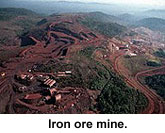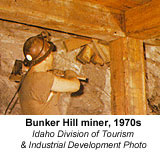Idaho has many different types of minerals, and it was gold that brought the first permanent white settlers to the state. Although minerals can be used up, we are lucky to have enough minerals to meet our needs for hundreds of years to come. Explore the natural history of Idaho mining with the photographs and text below.
Almost every important mineral except oil, gas and coal can be found in Idaho. Some would cost too much to mine, but others provide us with jobs and money.
The discovery of gold caused the Idaho territory to be established in 1863. As the gold deposits began to disappear, the search for other minerals began. By the late 1800s silver, lead and zinc deposits were uncovered in the Coeur d'Alene area. This area has become known as one of the world's richest mineral areas. Idaho today produces the most newly mined silver in the nation. Almost 45 per cent of all silver mined in the United States comes from Idaho. Silver and phosphate are the two major minerals produced in Idaho. We are the nation's second largest producer of phosphate with 15 per cent of the United States yearly production.
Although Idaho produces little gold, the United States Bureau of Mines says that we have more mineable gold than any other state. In recent years, as the price of gold has risen, many old mines have been reopened and the value of gold produced in Idaho has grown steadily.
 Other minerals in Idaho that have some importance are sand, gravel and crushed rock, copper, tungsten, garnets and clay. Garnets are used for polishing materials in industry. The amount of garnets in the state is large. Clay used in a variety of ways is plentiful in Idaho, but has not been developed to a very large degree at the present time.
Other minerals in Idaho that have some importance are sand, gravel and crushed rock, copper, tungsten, garnets and clay. Garnets are used for polishing materials in industry. The amount of garnets in the state is large. Clay used in a variety of ways is plentiful in Idaho, but has not been developed to a very large degree at the present time.Many types of semi-precious and precious stones are found in Idaho. Whether precious stones or sand and gravel, minerals are an important natural resource for Idaho.
When thinking about history and miners, we usually think of men with picks, shovels, gold pans, and perhaps a burro. The truth is, most of these men made very little money. It took five to ten minutes to wash the sand and gravel out of the pan, and the miner often found only five to ten cents worth of gold for his work. A few "struck it rich," but most men made only a few dollars a, day. That took the glitter out of gold for many men. The smart miners soon learned they would have to use machinery to make money from mining.
 The gold rush ended when the easy gold ran out, but the real mining began after that. Most of Idaho's placer gold was gone by the time Noah Kellogg (and his burro) found that lump of lead and silver ore in Shoshone County in 1885. This led to more wealth in silver, lead, and zinc than the gold miners could have ever dreamed of finding. After railroads were built through the mining country, hard-rock mines could be developed.
The gold rush ended when the easy gold ran out, but the real mining began after that. Most of Idaho's placer gold was gone by the time Noah Kellogg (and his burro) found that lump of lead and silver ore in Shoshone County in 1885. This led to more wealth in silver, lead, and zinc than the gold miners could have ever dreamed of finding. After railroads were built through the mining country, hard-rock mines could be developed. Today the Coeur d'Alene mining district (mostly in Shoshone County) is one of the two richest metal mining areas in the world. This part of Idaho has produced about 2 billion dollars in metal wealth since it began in 1885. Silver has -been Idaho's leading mineral for several years. The three richest silver mines in the United States are in Shoshone County. The Sunshine mine is the largest, the Galena mine is second, and the Bunker Hill is third. The Coeur d'Alene mines produce more silver than all the rest of the states together. The Bunker Hill mine is America's largest lead-silver mine. In mines such as the Bunker Hill, lead and silver are found mixed together. The Star mine is America's largest producer of zinc. (The city of Coeur d'Alene is not part of the Coeur d'Alene mining district. It is in Kootenai County on the edge of Lake Coeur d'Alene. The mines are in Shoshone County on the upper part of the Coeur d'Alene River.)
Today the Coeur d'Alene mining district (mostly in Shoshone County) is one of the two richest metal mining areas in the world. This part of Idaho has produced about 2 billion dollars in metal wealth since it began in 1885. Silver has -been Idaho's leading mineral for several years. The three richest silver mines in the United States are in Shoshone County. The Sunshine mine is the largest, the Galena mine is second, and the Bunker Hill is third. The Coeur d'Alene mines produce more silver than all the rest of the states together. The Bunker Hill mine is America's largest lead-silver mine. In mines such as the Bunker Hill, lead and silver are found mixed together. The Star mine is America's largest producer of zinc. (The city of Coeur d'Alene is not part of the Coeur d'Alene mining district. It is in Kootenai County on the edge of Lake Coeur d'Alene. The mines are in Shoshone County on the upper part of the Coeur d'Alene River.)Metals are mined in other parts of Idaho, also. Dredge mining of gold is done on some parts of the Salmon River. Here sand and gravel are scraped from the bottom of the river and washed for placer gold. Silver and lead are mined in the Wood River galena mines in Blaine County. Tungsten and cobalt are mined in Lemhi County. Vanadium* is mined in Bear Lake and Caribou counties.
Work is being done also to develop mines for other Idaho metals. There is molybdenum* in Bonner, Custer, and Lemhi counties; platinum* in Bonneville, Idaho, and Valley counties; and thorium* in Boundary and Lemhi counties. Thorium is a metal that could take the place of uranium* for atomic energy.
Of the following metals, some are now being mined in Idaho, and some are not. However, these are the most important metals found in Idaho: antimony*, beryllium*, chromium*, cobalt*, copper, gold, lead, molybdenum, platinum, silver, thorium, tungsten*, vanadium, and zinc.
When we think of mining, we often think of exciting metals like gold and silver. However, there are many important minerals which are not metals. These are called industrial minerals. Idaho is rich in industrial minerals. Idaho has seventy-two kinds of gem stones. This is more than any other state, and second only to Africa in the rest of the world. Agates, jade, opal, garnet (pink, green, and red), and diamonds-to name a few-have all been found in Idaho. It is believed the biggest diamond ever found in the United States - weighing nineteen and one-half carats - was found between McCall and New Meadows. (Idaho's state gem is the star garnet.)
Other industrial minerals are not as exciting as opals and diamonds, but they bring Idaho more wealth. It may be hard to think of stone, gypsum, cement, and clay as important minerals. However, they are widely used and are very valuable. Idaho's leading industrial mineral, and fastest growing, is phosphate*.
Most of Idaho's phosphate mining is done in eastern Idaho around Soda Springs. It is believed more than half of America's phosphate reserves are in Idaho in Bear Lake, Bingham, Bonneville, and Caribou counties.
Phosphate was Idaho's second leading mineral in 1974, and was very close to silver in value. Phosphate is used to make ammonium phosphate fertilizer and other important chemicals.
Below are several important Idaho industrial minerals and their uses:
cement - concrete and construction clay - brick and tile garnet - gems and sandpaper gypsum - fertilizer and
wall board lime - sugar beet processing phosphate - fertilizer and chemicals pumice - concrete and construction
sand and gravel - roads, concrete, and construction stone - building construction
Mining is an important source of income for towns near the mines and processing plants. Mining makes jobs and money for many people, those working in the mines, and those working in businesses which serve the mining families. Kellogg, Wallace, Mullan, and several smaller towns depend on the Coeur d'Alene mines. The phosphate mines of eastern Idaho bring wealth to Soda Springs, Blackfoot, Pocatello, and other towns.
The story of mining in Idaho should close with the story of Stibnite, one of Idaho's youngest ghost towns. Stibnite is also the mineral name for antimony ore. Mining for gold and antimony began at Stibnite in 1931. Later a body of rich tungsten ore was found. During World War 11, Stibnite produced ninety-eight percent of America's antimony, and much of her tungsten. Both metals were vital for making machines and weapons for fighting the war. The rich tungsten ore had run out by the end of the war in 1945. Later a. rich antimony mine opened in Central America. The new mine made the price of antimony drop so low, the Stibnite mine could not stay in business. It closed in 1952. Today only the pieces of a few old buildings and machines remain. The huge open-pit mine, once busy with men, machines, and trucks, has become a small mountain lake.
